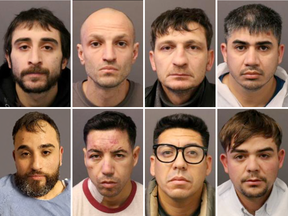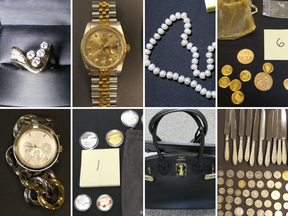'Theft groups enter Canada shortly after DST ends in the fall and return home to their countries in the spring after they’ve committed crime' police say

Article content
Organized burglary gangs blending sophistication with brute force are wintering in Canada from Latin America and Eastern Europe as “crime tourists,” coming to take advantage of early seasonal darkness and Canadian habits to ransack and loot homes.
The latest evidence of roving, criminal networks of seasonal migrants comes from York Region, a large municipality north of Toronto, where 20 people from six separate crime groups were arrested after a four-month probe into home break and enters.
“This is a cyclical trend that we’ve seen for multiple years now,” said Det.-Sgt. Pat Smyth, commander of York Regional Police’s Integrated Property Crime Task Force.
“Latin American theft groups and Eastern European theft groups enter Canada shortly after daylight saving ends in the fall and return home to their countries in the spring after they’ve committed crime.”
Those arrested in York police’s Project Dusk are “crime tourists,” he said.
Alvaro Almeida, deputy chief of York police, said their plans were purposeful and well organized.
“Every single one of these individuals arrived in York Region from outside the borders of Canada and we believe their sole purpose for coming here was to commit crime for profit,” Almeida said. “They are here purely for profit.”
They are here purely for profit
Reduced daylight in winter in Canada provides a sweet spot for bandits watching and waiting for targets while darkness hides their movements and there is less chance of people being home when they smash their way in.
“They know that it’s now getting dark here around 5:30, when people come home from work and then go out to get groceries, they go to their kids’ sports, they go out for dinner, or they go to the gym,” Smyth said.
The gangs monitor affluent neighbourhoods in and around Toronto. Most break-ins happened between 6 p.m. and 10 p.m., he said.
“There’s a time period when they know no one’s at home. They do surveillance. And they’ll sit and watch, and identify when people are coming, when people are going. And then they’ll do the break in.”
Some of the burglars used illegal signal jammers to defeat surveillance cameras, cellphones, and some alarm systems, and signal detectors to reveal security systems and hidden cameras.
After patience picking a target, they switch to a blitz-style burglary.
Sometimes the bandits kick in a rear or side door, even a front door. Police seized several “entry kits” that included pry bars and punch tools, used to smash glass, such as sliding patio doors or windows.

Then they swarm in, smashing and grabbing, upending anything in their way as they rummage through drawers, cupboards, and shelves for easy-to-carry valuables. They love watches, jewelry, cash, passports, luxury handbags, small electronics, designer clothes, and collectibles.
“They’re literally in there only minutes. They turn over the rooms and get out,” Smyth said. Often the valuables are stuffed in grocery store bags, so they don’t look odd carrying bulging bags. Sometimes they use suitcases found in the home to carry their loot.
Police allege the 20 people arrested and one fugitive are linked to 47 specific burglaries. Police recovered more than $2 million dollars worth of valuables. There are many more burglaries that investigators suspect, but have not been able to prove, were the work of the various tourist gangs — hundreds more.
Among those arrested in six waves from October to January are eight people from Chile and one from Albania. Others arrested have residential addresses listed in Toronto and York Region, many of them citizens of Georgia.
One burglary victim, whose home was allegedly hit by some of those charged, said the loss goes far beyond monetary value.
“This is not just about stolen belongings. It is about the destruction of our sense of safety, our peace of mind, and the precious memories of my dad that will never be replaced,” Natalia said. She asked that her last name not be published. Among the things stolen from her family are the only mementos of her father, who died when she was a baby, including her parents’ engagement and wedding rings.
Her mother went out just for an hour to have winter tires put on her car when a burglary team hit their house. They ransacked it.
I knew that nothing would ever be the same
“The moment I walked through that door I knew that nothing would ever be the same. Our house was torn apart, every single drawer emptied, every piece of furniture overturned. Every inch of our home violated,” Natalia said.
“We have several cameras, different cameras, but not a single one happened to work during that specific hour.”
“Then came the hardest part, figuring out what was taken. No one truly understands this part. You don’t just make a list and move on. You stare at what’s left, trying to piece together what’s missing while your heart races.”
Some of the crime tourists came to Canada by air, landing at Toronto’s Pearson airport. Many crossed by land from the United States. For some, police aren’t sure how they got here.
Not being residents in Canada gives them a layer of anonymity. Most are strangers to police. Several used false identity papers.
Once they arrive, they know what they’re doing and at least some have established connections. They buy prepaid burner phones. There are people who supply them with cheap vehicles to use, with fake registration and insurance documents in case they are asked to show them to police in a traffic stop.
“Unless they did an in-depth check on it, it would look like a regular vehicle, so there is definitely a network of support,” said Smyth.
It all sounds expensive, but Smyth said the underworld economics work in the criminals’ favour: “It more than pays for itself for them to come here.”
The stolen goods are sometimes shipped back home to be sold when they return, or by a relative. Other goods are sold locally. They know jewellery stores where they aren’t asked questions. There it can be melted into raw gold or silver that can no longer be identified as a stolen item.
Watches and electronics are sometimes sold to pawn shops, or through online marketplaces. There are local fences, criminals who specialize in liquidating stolen merchandise, who can help.
It more than pays for itself for them to come here
They also don’t have much fear of the Canadian justice system.
Often, someone caught is quickly deported rather than prosecuted. They can then get a new fake passport and come back next season. Smyth has seen repeat offenders come in over the years.
Last year, Smyth’s team arrested five other Chilean nationals who were accused of breaking into homes throughout the Greater Toronto Area from their base in a rental property in Oakville.
“Sometimes there’s not enough willingness to prosecute because — the explanation I’m given is — there’s no violence, it’s a property crime,” he said.
“When we have people that are coming in from another country, they’re more interested in deporting these people versus prosecuting them. We’re taking a different stance now in that we’re going to prosecute them first. They’ll do their jail time here as a deterrent and then we will deport them.
“There needs to be more teeth to make it more of a deterrent.”
In December, two men from the United Kingdom were ordered deported after a short stint in jail after spending their vacation trying to swindle homeowners in Sarnia and Hamilton by selling home repair services.
“Go home,” Justice Paul Kowalyshyn told the pair in a Sarnia courtroom. “Don’t let the door of the plane hit you on your backsides as you board.”
In 2015, Toronto was hit by a Chilean burglary ring. Police arrested 12 Chile nationals after a series of thefts from jewelry stores. Gang members disabled alarms, used specialist tools, and are believed to have used false identification to cross the border from the United States.
In 2017, a big spike in home break-ins in Oakville was traced to two burglary rings and 15 citizens of Chile were later accused of 400 of them. Halton police then provided information to Australian police to help bust a related gang down under.
Police said Chilean burglary rings have also been detected in Quebec, Alberta, and British Columbia.
The phenomenon has been spreading throughout the United States for years. California and Florida were hard hit and then they spread north to New York, New Jersey, and beyond.
Last month in Cincinnati, 430 kilometres south of the Canadian border, three men from Chile were charged after a burglary at the home of Cincinnati Bengals quarterback Joe Burrow. The three men, authorities said, were just the “tip of the iceberg” for similar burglaries in the area.
Elena Iatarola, FBI Special Agent in Charge of the Cincinnati office, said the FBI has formally designated the organized burglary gangs as South American Theft Groups.
The hit on the NFL player’s home mirrored the pattern of many of the Canadian break-ins. Burrow’s home was targeted in the early evening when he was away playing a game in Dallas.
Kansas City Chiefs stars Travis Kelce and Patrick Mahomes, and NBA players Bobby Portis and Mike Conley have also been burgled while away at games. The FBI has started protecting professional athletes’ homes during games, when the burglary crews know the player will be out of the house.
https://nationalpost.com/news/canada/crime-tourists-in-canada
No comments:
Post a Comment